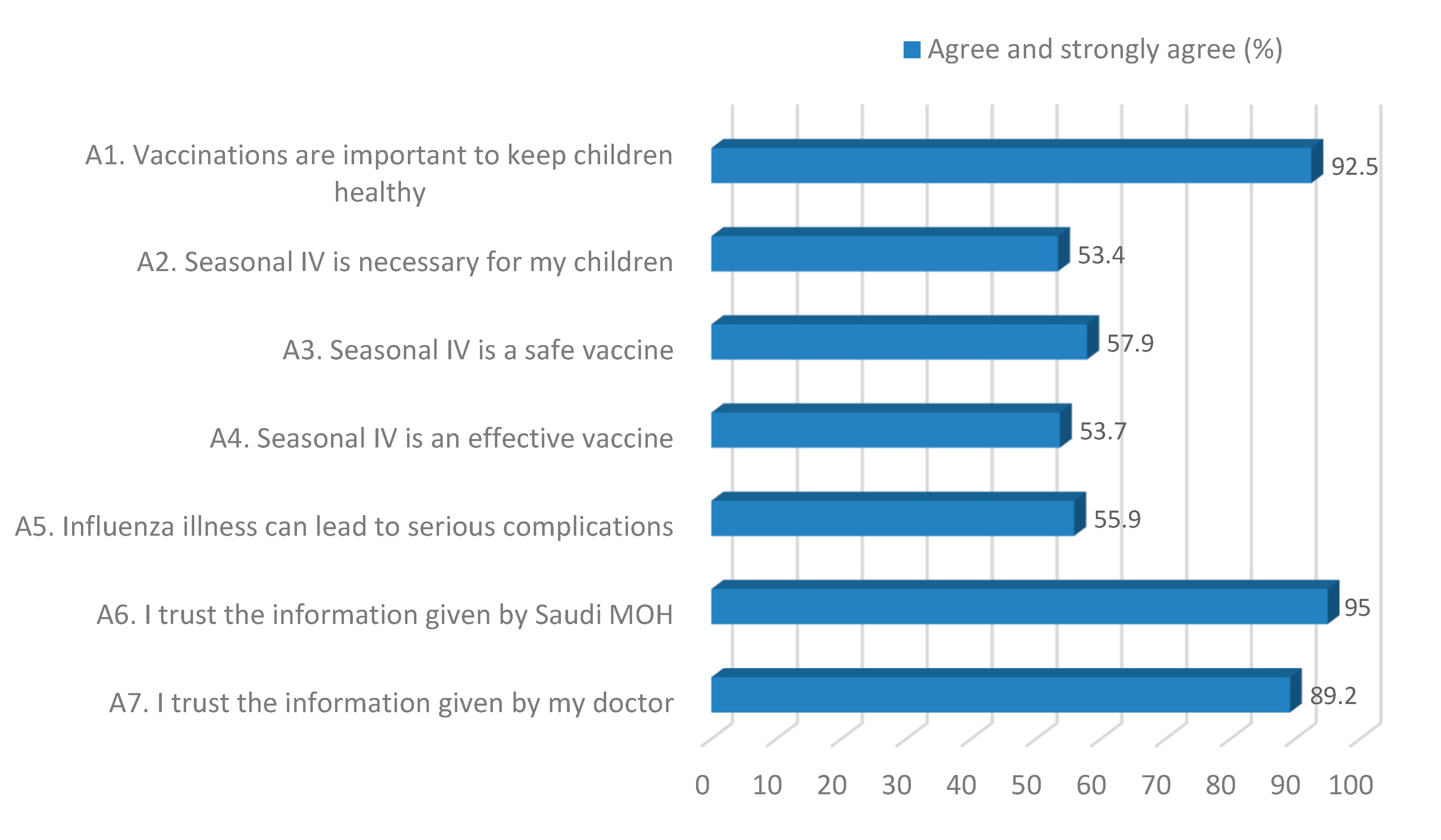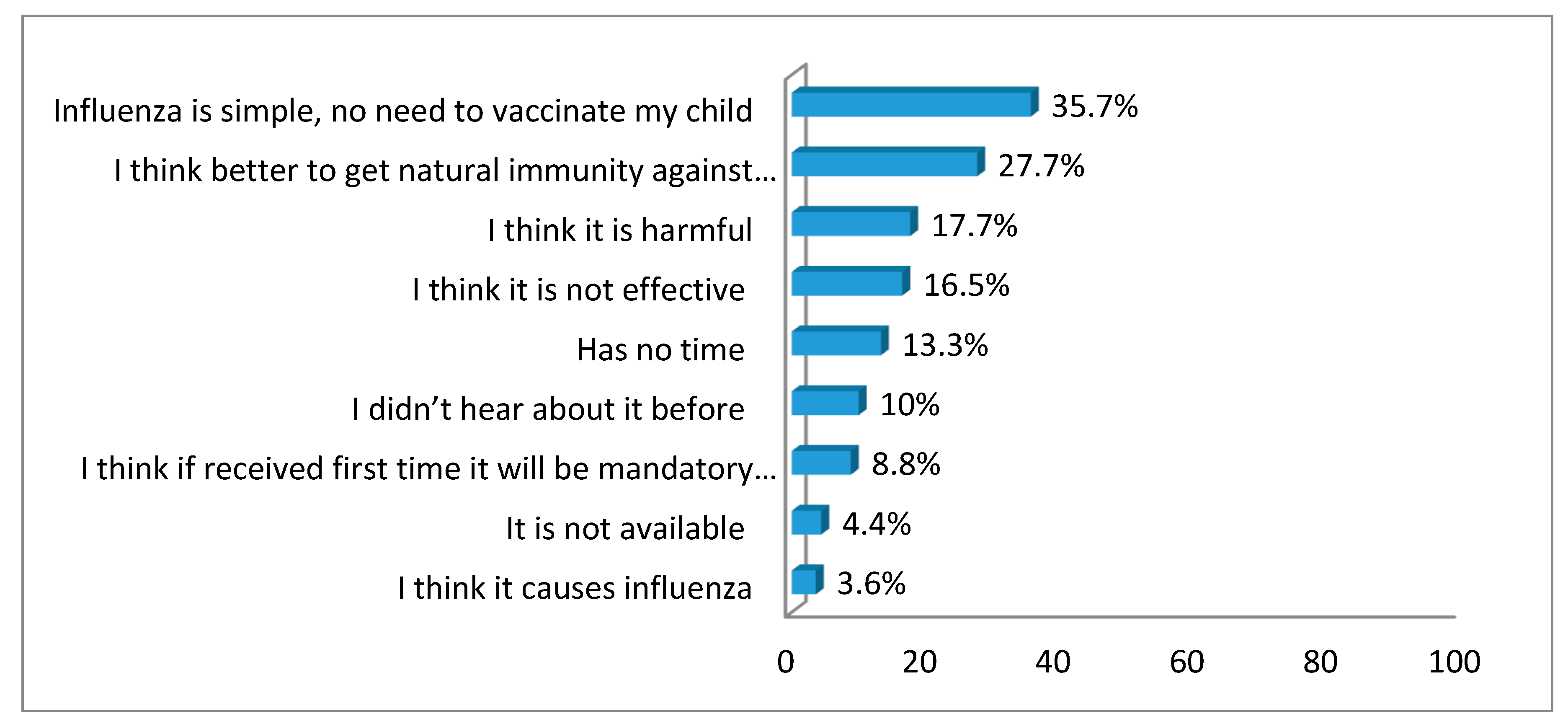Seasonal Influenza Vaccination among Saudi Children: Parental Barriers and Willingness to Vaccinate Their Children
Abstract
1. Introduction
2. Materials and Methods
3. Results
4. Discussion
5. Conclusions
Author Contributions
Funding
Acknowledgments
Conflicts of Interest
References
- World Health Organization. Influenza (Seasonal). 2018. Available online: https://www.who.int/news-room/fact-sheets/detail/influenza-(seasonal) (accessed on 12 May 2019).
- World Health Organization. Immunization, Vaccines and Biologicals. 2019. Available online: https://www.who.int/immunization/en/ (accessed on 12 May 2019).
- Appiah, G.D.; Blanton, L.; D’Mello, T.; Kniss, K.; Smith, S.; Mustaquim, D.; Steffens, C.; Dhara, R.; Cohen, J.; Chaves, S.S.; et al. Influenza activity—United States, 2014–2015 season and composition of the 2015–16 influenza vaccine. MMWR Morb. Mortal. Wkly. Rep. 2015, 64, 583–590. [Google Scholar] [PubMed]
- Recommendation for Prevention and Control of Influenza in Children, 2019–2020. Available online: https://www.aap.org/en-us/about-the-aap/aap-press-room/pages/Recommendations-for-Prevention-and-Control-of-Influenza-in-Children-2019-2020.aspx (accessed on 15 June 2019).
- Centers for Disease Control and Prevention. Estimates of Flu Vaccination Coverage among Children—United States, 2017–2018 Flu Season. Available online: https://www.cdc.gov/flu/fluvaxview/coverage-1718estimates-children.htm (accessed on 12 May 2019).
- Grohskopf, L.A.; Sokolow, L.Z.; Broder, K.R.; Walter, E.B.; Bresee, J.S.; Fry, A.M.; Jernigan, D.B. Prevention and control of seasonal influenza with vaccines: Recommendations of the Advisory Committee on Immunization Practices-United States, 2017–2018 influenza season. MMWR Recomm. Rep. 2017, 66, 1–20. [Google Scholar] [CrossRef] [PubMed]
- Saudi Ministry of Health. Childhood Vaccines Available Daily in all Health Centers. Available online: https://www.moh.gov.sa/en/Ministry/MediaCenter/News/Pages/News-2017-07-20-001.aspx (accessed on 20 October 2019).
- Zeitouni, M.O.; Al Barrak, A.M.; Al-Moamary, M.S.; Alharbi, N.S.; Idrees, M.M.; Al Shimemeri, A.A.; Al-Hajjaj, M.S. The Saudi Thoracic Society guidelines for influenza vaccinations. Ann. Thorac. Med. 2015, 10, 223–230. [Google Scholar] [CrossRef] [PubMed]
- Saudi Ministry of Health. Seasonal Influenza Vaccination. Available online: https://www.moh.gov.sa/en/Flu/Pages/QA.aspx (accessed on 20 October 2019).
- Jheeta, M.; Newell, J. Childhood vaccination in Africa and Asia: The effects of parents’ knowledge and attitudes. Bull. World Health Organ. 2008, 86, 419. [Google Scholar] [CrossRef] [PubMed]
- Bukhsh, A.; Rehman, H.; Mallhi, T.H.; Ata, H.; Rehman, I.U.; Lee, L.H.; Goh, B.H.; Khan, T.M. Parents’ attitude, awareness and behaviour towards influenza vaccination in Pakistan. Hum. Vaccin. Immunother. 2018, 14, 952–957. [Google Scholar] [CrossRef] [PubMed]
- Low, M.S.F.; Tan, H.; Hartman, M.; Tam, C.C.; Hoo, C.; Lim, J.; Chiow, S.; Lee, S.; Thng, R.; Cai, M.; et al. Parental perceptions of childhood seasonal influenza vaccination in Singapore: A cross-sectional survey. Vaccine 2017, 35, 6096–6102. [Google Scholar] [CrossRef] [PubMed]
- Ramprasad, C.; Zachariah, R.; Steinhoff, M.; Simon, A. Parental attitudes towards influenza vaccination for children in South India. World J. Pediatr. 2017, 13, 84–90. [Google Scholar] [CrossRef] [PubMed]
- Jung, M.; Lin, L.; Viswanath, K. Associations between health communication behaviors, neighborhood social capital, vaccine knowledge, and parents’ H1N1 vaccination of their children. Vaccine 2013, 31, 4860–4866. [Google Scholar] [CrossRef] [PubMed]
- Coniglio, M.A.; Platania, M.; Privitera, D.; Giammanco, G.; Pignato, S. Parents’ attitudes and behaviours towards recommended vaccinations in Sicily, Italy. BMC Public Health 2011, 11, 305. [Google Scholar] [CrossRef] [PubMed]
- Gargano, L.M.; Underwood, N.L.; Sales, J.M.; Seib, K.; Morfaw, C.; Murray, D.; DiClemente, R.J.; Hughes, J.M. Influence of sources of information about influenza vaccine on parental attitudes and adolescent vaccine receipt. Hum. Vaccin. Immunother. 2015, 11, 1641–1647. [Google Scholar] [CrossRef] [PubMed]
- Faden, A.A.; Al Mofeez, F.I.; Alsenaid, A.I.; Alyousef, M.A.; Shahad Ahmad Al-Musailhi, S.A.; Ali Gorab, A.H. Attitudes of parents towards the use of H1N1 vaccination in Saudi Arabia. Biosci. Biotechnol. Res. Asia 2015, 12, 2111–2116. [Google Scholar] [CrossRef][Green Version]
- Alabbad, A.A.; Alsaad, A.K.; Al Shaalan, M.A.; Alola, S.; Albanyan, E.A. Prevalence of influenza vaccine hesitancy at a tertiary care hospital in Riyadh, Saudi Arabia. J. Infect. Public Health 2018, 11, 491–499. [Google Scholar] [CrossRef] [PubMed]
- Awad, S.; Abdo, N.; Yusef, D.; Jawarneh, A.; Babaa, A.; Al-Bawayeh, H.; Kasrawi, I.; Amaireh, M.; Obeidat, M.; Alonze, S. 2019. Knowledge, attitudes and practices related to influenza illness and vaccination in children: Role of awareness campaigns in changing parents’ attitudes toward influenza vaccination in Jordan. Vaccine 2019, 37, 3303–3309. [Google Scholar] [CrossRef] [PubMed]
- Torun, S.D.; Torun, F.; Catak, B. Healthcare workers as parents: Attitudes toward vaccinating their children against pandemic influenza A/H1N1. BMC Public Health 2010, 10, 596. [Google Scholar] [CrossRef] [PubMed]
- Low, M.; Tan, H.Y.; Hartman, M.; Tam, C. Knowledge, attitudes and practices of parents towards childhood influenza vaccination in Singapore. Int. J. Infect. Dis. 2016, 53, 105–106. [Google Scholar] [CrossRef][Green Version]
- Alsuhaibani, M. Barriers and beliefs among health-care workers regarding seasonal influenza vaccine in Al-Qassim region, Saudi Arabia. Hum Vaccin Immunother. 2019, 5, 1–8. [Google Scholar] [CrossRef] [PubMed]
- Alshammari, T.M.; AlFehaid, L.S.; AlFraih, J.K.; Aljadhey, H.S. Health care professionals’ awareness of, knowledge about and attitude to influenza vaccination. Vaccine 2014, 32, 5957–5961. [Google Scholar] [CrossRef] [PubMed]


| Study Variables | n (%) (N = 399) |
|---|---|
| Gender | |
| Women | 276 (69.2) |
| Age group in years | |
| 18–24 | 32 (8.0) |
| 25–34 | 140 (35.1) |
| 35–44 | 128 (32.1) |
| 45–54 | 68 (17.0) |
| 55–65 | 31 (7.8) |
| Educational level | |
| Less than high school | 69 (17.3) |
| High school graduate | 117 (29.3) |
| College graduate | 203 (50.9) |
| Master’s or PhD | 10 (2.5) |
| Working in a medical field | |
| Yes | 62 (15.5) |
| No | 337 (84.5) |
| Household monthly income (Saudi Riyal) | |
| 2000–6000 | 42 (10.5) |
| 6001–10,000 | 49 (12.3) |
| 10,001–15,000 | 72 (18.0) |
| >15,000 | 26 (6.5) |
| Did not know/refused | 210 (52.6) |
| Number of children | |
| One | 116 (29.1) |
| Two | 100 (25.1) |
| Three | 82 (20.6) |
| Four or more | 101 (25.3) |
| City of residence | |
| Alrass | 162 (40.6) |
| Buraydah | 108 (27.1) |
| Unayzah | 129 (32.3) |
| Statement | Correct Answer n (%) (N = 399) |
|---|---|
| K1. Influenza is a common disease | 351 (88.0) |
| K2. Influenza is highly contagious | 291 (72.9) |
| K3. Influenza is transmitted through coughing and sneezing | 372 (93.2) |
| K4. Influenza can lead to hospitalization and death | 214 (53.6) |
| K5. The influenza vaccine is recommended for all children >6 months | 156 (39.1) |
| K6. The aim of the influenza vaccine is to prevent influenza | 115 (28.8) |
| K7. The influenza vaccine will not cause influenza | 162 (40.6) |
| K8. The influenza vaccine should be given every year | 227 (56.9) |
| K9. Antibiotics cannot treat a viral influenza infection | 76 (19.0) |
| Predictor | n (%) (N = 399) |
|---|---|
| Knowledge Score (mean ± SD) | 04.9 ± 01.7 |
| Knowledge level | |
| Poor | 246 (61.7) |
| Good | 153 (38.3) |
| Attitude Score (mean ± SD) | 28.3 ± 04.3 |
| Attitude level | |
| Negative | 21 (5.3) |
| Positive | 378 (94.7) |
| Factor | Knowledge Total Score (out of 9) Mean ± SD | p-Value | Attitude Total Score (out of 35) Mean ± SD | p-Value |
|---|---|---|---|---|
| Gendera | ||||
| Men | 05.1 ± 01.8 | 0.448 | 27.1 ± 04.8 | 0.003 ** |
| Women | 04.9 ± 01.7 | 28.8 ± 03.9 | ||
| Age group in yearsb | ||||
| 18–34 years | 04.8 ± 01.8 | 0.155 | 28.7 ± 04.2 | 0.284 |
| 35–44 years | 05.1 ± 01.8 | 27.9 ± 04.1 | ||
| >44 years | 04.8 ± 01.6 | 27.9 ± 04.6 | ||
| Educational levela | ||||
| High school or below | 04.5 ± 01.8 | <0.001 ** | 27.7 ± 04.7 | 0.020 ** |
| College graduate or higher | 05.2 ± 01.6 | 28.8 ± 03.8 | ||
| Working in medical fielda | ||||
| Yes | 05.9 ± 01.5 | <0.001 ** | 29.2 ± 04.4 | 0.020 ** |
| No | 04.7 ± 01.7 | 28.1 ± 04.2 | ||
| Household monthly income (SAR)b | ||||
| ≤10,000 | 04.7 ± 01.8 | <0.001 ** | 29.1 ± 04.5 | 0.032 ** |
| >10,000 | 05.5 ± 01.8 | 28.6 ± 03.9 | ||
| Refused | 04.7 ± 01.6 | 27.8 ± 04.3 | ||
| Number of childrenb | ||||
| One | 04.7 ± 01.6 | 0.120 | 28.3 ± 03.6 | 0.551 |
| Two | 04.8 ± 01.7 | 27.7 ± 04.6 | ||
| Three | 04.9 ± 01.7 | 28.6 ± 04.1 | ||
| Four or more | 05.2 ± 01.8 | 28.4 ± 04.8 | ||
| City of residenceb | ||||
| Alrass | 04.9 ± 01.7 | 0.808 | 27.8 ± 04.9 | 0.616 |
| Buraydah | 04.9 ± 01.8 | 28.5 ± 03.7 | ||
| Unayzah | 04.9 ± 01.7 | 28.6 ± 03.8 | ||
| Heard about seasonal vaccinea | ||||
| Yes | 05.2 ± 01.6 | <0.001 ** | 28.4 ± 04.2 | 0.073 |
| No | 03.5 ± 01.6 | 27.4 ± 04.5 | ||
| Received influenza vaccine as a parenta | ||||
| Yes | 05.7 ± 01.6 | <0.001 ** | 29.5 ± 04.1 | <0.001 ** |
| No | 04.3 ± 01.5 | 27.2 ± 04.1 | ||
| Child received influenza vaccinea | ||||
| Yes | 05.7 ± 01.6 | <0.001 ** | 30.5 ± 03.3 | <0.001 ** |
| No | 04.4 ± 01.6 | 26.9 ± 04.2 |
© 2019 by the authors. Licensee MDPI, Basel, Switzerland. This article is an open access article distributed under the terms and conditions of the Creative Commons Attribution (CC BY) license (http://creativecommons.org/licenses/by/4.0/).
Share and Cite
Alolayan, A.; Almotairi, B.; Alshammari, S.; Alhearri, M.; Alsuhaibani, M. Seasonal Influenza Vaccination among Saudi Children: Parental Barriers and Willingness to Vaccinate Their Children. Int. J. Environ. Res. Public Health 2019, 16, 4226. https://doi.org/10.3390/ijerph16214226
Alolayan A, Almotairi B, Alshammari S, Alhearri M, Alsuhaibani M. Seasonal Influenza Vaccination among Saudi Children: Parental Barriers and Willingness to Vaccinate Their Children. International Journal of Environmental Research and Public Health. 2019; 16(21):4226. https://doi.org/10.3390/ijerph16214226
Chicago/Turabian StyleAlolayan, Abdullah, Bdoor Almotairi, Shouq Alshammari, Malak Alhearri, and Mohammed Alsuhaibani. 2019. "Seasonal Influenza Vaccination among Saudi Children: Parental Barriers and Willingness to Vaccinate Their Children" International Journal of Environmental Research and Public Health 16, no. 21: 4226. https://doi.org/10.3390/ijerph16214226
APA StyleAlolayan, A., Almotairi, B., Alshammari, S., Alhearri, M., & Alsuhaibani, M. (2019). Seasonal Influenza Vaccination among Saudi Children: Parental Barriers and Willingness to Vaccinate Their Children. International Journal of Environmental Research and Public Health, 16(21), 4226. https://doi.org/10.3390/ijerph16214226





